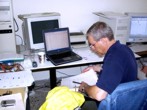|
|
| Study of the material |
 The research at Paliambela occupies a large number of specialist scientists who collect and study every kind of data that can throw light on the past. During each excavation season the complete collection and methodical sampling using suitable equipment is carried out, so that reliable archaeological data is gathered and recorded, with a view to their further analysis. The research at Paliambela occupies a large number of specialist scientists who collect and study every kind of data that can throw light on the past. During each excavation season the complete collection and methodical sampling using suitable equipment is carried out, so that reliable archaeological data is gathered and recorded, with a view to their further analysis. |
| |
| Study |
|
The study of the material is carried out in various stages. The first stage is the systematic recording of the archaeological information which includes planning, photography, and cataloguing, depending on the type of find. This is followed by the stages of quantification and statistical analysis which give extra information on the quantitative relationships of the archaeological material. An important part of the process is the dating and survey analysis of the finds with the aim of uncovering the order of human behaviour in space and time. |
|
|
| |
| Laboratory analyses |
| A special mention must be made of the laboratory analyses which are undertaken on part of the archaeological material from the excavations at Paliambela. The modern study uses advanced techniques and special equipment which offer the researcher the capabilities of chemical, magnetic, geophysical, and microscopic analyses.
|
The benefits of these analyses include the determination of materials, and of morphological and technical characteristics invisible to the human eye or other types of conventional observation methods. The gathering of comprehensive conclusions about the type and the characteristics of human activity is incomplete without the implementation of these special analyses. |
| |
| Expected Findings |
 The findings of the studies will allow the researchers to complete, as far as is possible, the mosaic of human activity at the site of Paliambela. In this way, many issues will be clarified, such as elements of the social life and organisation of the inhabitants (the role of the family and the household, the role of reciprocity and of redistribution in social transactions), and elements of the social identity of the inhabitants (social gender, cultural identity). They will also shed light on the economic and production activities of the inhabitants, as well as their relationship with the environment and the landscape. Finally, their perceptions, and changes in their ideology from one period to another, can be approached. The findings of the studies will allow the researchers to complete, as far as is possible, the mosaic of human activity at the site of Paliambela. In this way, many issues will be clarified, such as elements of the social life and organisation of the inhabitants (the role of the family and the household, the role of reciprocity and of redistribution in social transactions), and elements of the social identity of the inhabitants (social gender, cultural identity). They will also shed light on the economic and production activities of the inhabitants, as well as their relationship with the environment and the landscape. Finally, their perceptions, and changes in their ideology from one period to another, can be approached. |
|
|





